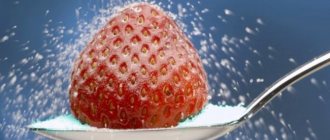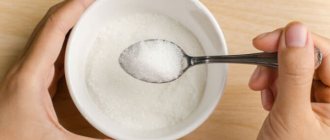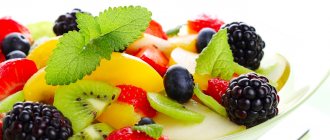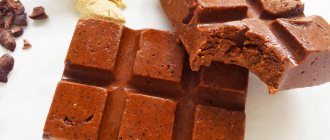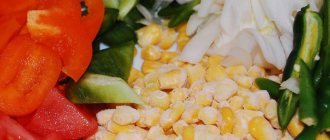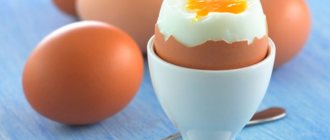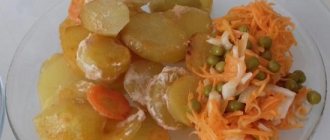Natural fructose is a monosaccharide that is contained in all fruits, sweet vegetables, berries and honey. In pharmacies and stores you can buy fructose in its pure form - a white crystalline powder. Confectionery products are also produced on its basis: candies, waffles, cookies, chocolate. Fruit sugar is almost twice as sweet as regular sugar, and its calorie content is slightly lower. These features allow the use of carbohydrates in dietary nutrition. However, fructose cannot be used uncontrollably. It has fewer contraindications than glucose, but they do exist.
No time to read? All text in a minute
- Consuming fructose as a sweetener is hazardous to your health.
- Regularly consuming fructose-containing foods is the same as binge drinking - the effect on the liver is similar.
- Fruits do contain fructose. Fruits are natural, but toadstools are also poisonous? The fruits are, of course, not poisonous. But their benefits and naturalness are greatly exaggerated.
- The products typically use fructose powder or fructose syrup (fructose-glucose syrup, glucose-fructose syrup). These are toxic ingredients and should be avoided – always.
Dietary recommendations for fructose intolerance
People with fructose intolerance should know and follow the following principle: fructose is better absorbed in the intestines and does not cause irritation in the presence of glucose, and the optimal proportion is important here .
| Consumption of fructose and glucose in equal quantities promotes complete absorption of fructose in both those who suffer from functional intestinal diseases and healthy people. Therefore, it is recommended to limit foods with excess fructose content, i.e. those that contain more fructose than glucose. |
Fruits and juices that contain more glucose or at least no less than fructose - bananas, strawberries - are well tolerated. Conversely, discomfort in the intestines can be caused by fruits with excess fructose (or the total amount of fructose with sorbitol), such as cherries, apples, pears, especially if you eat a lot of them and without adding other food.
| If you suspect you have fructose intolerance, then, since each body is individual, the best recommendation may be to study your own reactions to specific foods by temporarily eliminating them. |
If you suspect fructose intolerance, try the following recommendations for certain foods:
- industrially processed products that contain the ingredients “fructose” or “crystalline fructose” (namely these, not glucose-fructose syrup) should be excluded;
- products containing glucose-fructose syrup should be consumed in moderation, not exceeding the recommended servings;
- Juices and fruits high in fructose should also be consumed in moderation, as part of meals, without sweetened alcoholic beverages and without lactose-containing products if you are lactose intolerant. A reasonable solution is to include no more than two servings of foods with excess fructose content, including drinks.
If symptoms of fructose intolerance continue to be felt despite the restriction, it makes sense to experiment with completely eliminating foods with excess fructose - both industrially processed and natural.
Author: Anastasia Zorina, employee of the scientific department
References: 1. Akhavan T, Anderson GH. Effects of glucose-to-fructose ratios in solutions on subjective satiety, food intake, and satiety hormones in young men. Am J Clin Nutr. 2007 Nov;86(5):1354-63. 2. Beyer PL, Caviar EM, McCallum RW. Fructose intake at current levels in the United States may cause gastrointestinal distress in normal adults. J Am Diet Assoc. 2005 Oct;105(10):1559-66. 3. Beyreiss K, Hoepffner W, Scheerschmidt G, Müller F. Digestion and absorption rates of lactose, glucose, galactose, and fructose in three infants with congenital glucose-galactose malabsorption: perfusion studies. J Pediatr Gastroenterol Nutr. 1985 Dec;4(6):887-92. 4. Douard V, Ferraris RP. The role of fructose transporters in diseases linked to excessive fructose intake. J Physiol. 2013 Jan 15;591(2):401-14. 5. Frieling T, Kuhlbusch-Zicklam R, Kalde S, Heise J, Hülsdonk A, Kreysel C. Fructose malabsorption: how much fructose can a healthy subject tolerate? Digestion. 2011;84(4):269-72. 6. Gibson PR, Newnham E, Barrett JS, Shepherd SJ, Muir JG. Review article: fructose malabsorption and the bigger picture. Aliment Pharmacol Ther. 2007 Feb 15;25(4):349-63. 7. Jones HF, Butler RN, Brooks DA. Intestinal fructose transport and malabsorption in humans. Am J Physiol Gastrointest Liver Physiol. 2011 Feb;300(2):G202-6. 8. Kyaw MH, Mayberry JF. Fructose malabsorption: true condition or a variance from normality. Fructose malabsorption: true condition or a variance from normality. 9. Khanal RC, Howard LR, Rogers TJ, Wilkes SE, Dhakal IB, Prior RL. Effect of feeding grape pomace on selected metabolic parameters associated with high fructose feeding in growing Sprague-Dawley rats. J Med Food. 2011 Dec;14(12):1562-9. 10. Kurbel S. Arterial hypertension due to fructose ingestion: model based on intermittent osmotic fluid trapping in the small bowel. Theor Biol Med Model. 2010 Jun 25;7:27. 11. Moran TH. Fructose and satiety. J Nutr. 2009 Jun;139(6):1253S-1256S. 12. Ohashi K, Munetsuna E, Yamada H, Ando Y, Yamazaki M, Taromaru N, Nagura A, Ishikawa H, Suzuki K, Teradaira R, Hashimoto S. High fructose consumption induces DNA methylation at PPARα and CPT1A promoter regions in the rat liver. Biochem Biophys Res Commun. 2015 Dec 4-11;468(1-2):185-9. 13. Perman JA. Digestion and absorption of fruit juice carbohydrates. J Am Coll Nutr. 1996 Oct;15(5 Suppl):12S-17S. 14. Rao SS, Attaluri A, Anderson L, Stumbo P. Ability of the normal human small intestine to absorb fructose: evaluation by breath testing. Clin Gastroenterol Hepatol. 2007 Aug;5(8):959-63. Epub 2007 Jul 10. 15. Ravich WJ, Bayless TM, Thomas M. Fructose: incomplete intestinal absorption in humans. Gastroenterology. 1983 Jan;84(1):26-9. 16. Rippe JM, Angelopoulos TJ. Sucrose, high-fructose corn syrup, and fructose, their metabolism and potential health effects: what do we really know? Adv Nutr. 2013 Mar 1;4(2):236-45. 17. Rumessen JJ. Fructose and related food carbohydrates. Sources, intake, absorption, and clinical implications. Scand J Gastroenterol. 1992 Oct;27(10):819-28. 18. Saad AF, Alshehri W, Lei J, Kechichian TB, Gamble P, Alhejaily N, Shabi Y, Saade GR, Costantine MM, Burd I. Maternal Fructose Consumption Disrupts Brain Development of Offspring in a Murine Model of Autism Spectrum Disorder. Am J Perinatol. 2016 May 2 19. Saad AF, Dickerson J, Kechichian TB, Yin H, Gamble P, Salazar A, Patrikeev I, Motamedi M, Saade GR, Costantine MM. High-fructose diet in pregnancy leads to fetal programming of hypertension, insulin resistance, and obesity in adult offspring. Am J Obstet Gynecol. 2016 Apr 7. pii: S0002-9378(16)00530-5. 20. Skoog SM, Bharucha AE. Dietary fructose and gastrointestinal symptoms: a review. Am J Gastroenterol. 2004 Oct;99(10):2046-50. 21. Soleimani M. Dietary fructose, salt absorption and hypertension in metabolic syndrome: towards a new paradigm. Acta Physiol (Oxf). 2011 Jan;201(1):55-62. 22. White JS. Misconceptions about high-fructose corn syrup: is it uniquely responsible for obesity, reactive dicarbonyl compounds, and advanced glycation endproducts? J Nutr. 2009 Jun;139(6):1219S-1227S. 23. White JS. Straight talk about high-fructose corn syrup: what it is and what it ain't. Am J Clin Nutr. 2008 Dec;88(6):1716S-1721S. 24. Wright EM, Martín MG, Turk E. Intestinal absorption in health and disease–sugars. Best Pract Res Clin Gastroenterol. 2003 Dec;17(6):943-56. 25. Murzin I. Both are so delicious! Review of the Russian market of glucose-fructose syrups. Russian Food&Drinks Market Magazine. №4/2011
What is fructose?
This is a monosaccharide that does not break down into simpler components, the simplest source of carbohydrate energy.
The formula of fructose is the same as the formula of glucose – C6H12O6. These are isomers, that is, compounds with the same atomic composition, but at the same time different in structure and arrangement of atoms in space. Because of this, they behave differently in the body.
Glucose and fructose: what is the difference
Glucose gives a feeling of fullness and energy, increases blood sugar levels and, accordingly, insulin (in healthy people). Injures blood vessels, nerve cells, increases inflammation in the body. 1 g of glucose contains 3.4 kcal.
Fructose does not affect blood sugar and does not interfere with insulin; it gives foods a sweet taste - sweeter than glucose. Calorie content of fructose – 3.96 g.
Specialists
| 4.6 4 reviews | Ignatova Olga Yurievna Endocrinologist Experience 17 years Admission from 6695 rub. |
| 4.6 83 reviews | Timofeeva Galina Dmitrievna Endocrinologist Experience 39 years Doctor of the highest category Admission from 2200 rub. |
| 4.6 8 reviews | Manushakyan Grigory Aramovich Endocrinologist Experience 15 years Admission from 6500 rub. |
Why is fructose dangerous?
“With fructose,” the product label for diabetics happily tells us. There is no insulin response to fructose, so it is considered a safe sweetener for those who need to monitor their blood sugar levels. And then what harm can we talk about from fructose?
If glucose can be used by all cells of the body, then only the liver deals with fructose. This organ can use very small amounts of fructose. He puts off everything else until better times (or rather worse, when energy is urgently needed). With excessive consumption of fructose, hepatosis develops - fatty liver. Later – cirrhosis. Just like alcoholics, but a little faster.
When a person consumes a lot of fructose, triglycerides in the blood increase (more than from glucose). Visceral fat, the fat that surrounds the internal organs, begins to grow. A person with this type of obesity may be thin but look a little (or a lot) pregnant.
In diabetes, the body makes no (or very little) insulin, the hormone that is supposed to send glucose into cells. Diabetics have to take insulin to keep their blood sugar levels normal. Unfortunately, instead of being advised to avoid carbohydrates, diabetics are taught to time their insulin levels for sweet foods, and fructose is offered as a healthy alternative to sugar. But this only makes their problems worse. Many people with diabetes cannot lose excess weight for years, and they often develop cardiovascular diseases.
The benefits and harms of fructose for the body
The results of the tests showed that the benefits of fructose for the body are as follows: it prevents the occurrence of diabetes mellitus and promotes a faster breakdown of alcohol.
Since fructose has a low glycemic index, it can be consumed even by people suffering from insulin-dependent type 1 diabetes. In order to process fructose, the body also needs insulin, but 5 times less than in the case of glucose.
Those who have been diagnosed with diabetes need to carefully consider their diet and adhere to a healthy diet. It is recommended to replace glucose with fructose to diversify your diet. Thanks to the production of fructose on an industrial scale, it has become possible to produce various products for diabetics.
The safe dose of fructose is no more than 40 g, this is explained by the fact that compared to sucrose it has a low glycemic index. Fructose tastes sweeter than sugar, which means it can be added in small quantities when making sweets.
The benefits and harms of fructose for the body
Those with type 2 diabetes are often obese, so these people can consume up to 30 g of fructose per day. Otherwise, you can experience not only the benefits, but also the harm from fructose for the body.
What advantages does fructose have over glucose:
- Fructose has the same calorie content as sugar, but it is 2 times sweeter. Therefore, you can add it in smaller quantities, which will lead to a decrease in calorie intake. For example, coffee will be sweet if you add just one spoon of fructose to it, rather than two spoons of sugar. In this case, the energy value of coffee will be 2 times less. If you consume fructose correctly, you will be able to lose weight.
- Since energy is consumed for a long time, consuming fructose, a person will not get tired after physical activity, and recovery processes will begin to proceed faster.
- Of all the types of sugars, only fructose is hypoallergenic.
- Fructose helps preserve moisture and color of the product because it acts as a natural preservative.
- It practically does not cause fermentation and gas formation in the intestines, especially if you compare it with regular sugar.
- When consuming fructose, the risk of caries and plaque is reduced by 40%, and inflammation in the oral cavity is reduced. This is also a significant advantage of fructose over sugar.
How to Guaranteed Lose Weight with Water: 3 Simple Habits
There are almost no women in the world who have never been on a diet. Sooner or later, everyone faces the desire to lose a couple of kilograms.
In order for the treasured number to appear on the scales sooner, introduce 3 healthy and super simple habits into your life: we have prepared a document with experts where we describe them in detail.
Artyom Khachataryan
Practitioner, nutritionist, naturopath
75% of our course participants who follow these habits have significantly reduced their weight!
You can download the document for free:
Fructose brings not only benefits, but also harm to the body:
- It is important to soberly assess the situation, even taking into account the fact that fructose is low-calorie. Despite the fact that this substance has low energy value, this product cannot be called dietary. Yes, fructose is absorbed slowly and evenly, but it is precisely because of this that a person does not feel full for a long time. As a result of overeating, you cannot lose weight. Obesity and type 2 diabetes are a consequence of the fact that for 30 years the world's population has consumed artificial sweetener in foods and drinks. When your calorie intake is higher than normal, fructose will still be stored as fat. Moreover, deposition occurs in the abdominal cavity in the form of visceral fat.
- As fats from the liver enter the bloodstream, cholesterol levels rise sharply. This leads to the occurrence of vascular and heart diseases, increasing the risk of heart attacks and strokes. The amount of lipids increases due to fructose. Moreover, fat is deposited not only in problem areas, but also in the heart area. This leads to serious health problems.
- Store-bought juices contain large amounts of fructose. So, in one glass of the finished drink there are as many as 5 tablespoons of this substance. Continuous consumption of such juices increases the risk of colorectal cancer. In addition, consuming fructose in large quantities leads to diabetes. To protect yourself, you should consume no more than 150 ml of juice per day.
- Fructose is the “fuel” for cancer cells.
- If you consume fructose in large quantities, the intestinal microflora will change and pathogenic microorganisms will appear.
- If fructose intake is not controlled, the acid-base balance will be disrupted. This will lead to acidosis, the person will feel a loss of strength, he will experience arrhythmia, and drowsiness will appear.
- If you consume fructose for a long time, your uric acid levels will increase. As a result, blood pressure will increase, gout will begin, and kidney stones will appear.
This is interesting!
“The harm and benefits of gluten for the body” Read more
- The harm of fructose to the body lies in the fact that it does not enter directly into the cells of our body, but is first processed in the liver. This means that if you consume this sweetener in large quantities for a long time, liver diseases, such as cirrhosis, will begin. In addition, many doctors are confident that fructose has a detrimental effect on this organ, just like alcohol. The monosaccharide facilitates the work of the pancreas, increasing the load on the liver. Fructose is almost completely converted into lipids, which leads to fatty degeneration of the liver.
- The price of this sweetener is 4 times higher than sugar.
- Regular consumption of foods containing fructose leads to an increase in insulin synthesis, resulting in a person developing insulin resistance. To prevent this from happening, it is necessary to monitor the amount of fructose coming from food.
What foods contain fructose?
Even if you pass by the obscurantism in the diabetic section of the nearest supermarket, there is a chance that you are consuming more fructose than our liver can handle. Fructose is found in:
- Sahara
- Syrup (agave, maple, corn, Jerusalem artichoke, date)
- Möde
- Starchy vegetables and root vegetables
- Fruits
- Industrial sweets
Many “healthy,” “sugar-free,” “fitness,” and “diet” products contain “natural” fructose.
Please note that manufacturers of “healthy sweets” are very fond of this “natural sugar” (as we remember, it is cheap). Therefore, fructose can often be found in “healthy desserts” not for diabetics. Moreover, usually on the packaging it will be written in large letters “without sugar”, “naturally”, “with stevia”, and only a keen eye will detect harmful fructose in the composition.
If fructose is common in desserts (remember, it's cheap and sweet), then you probably wouldn't expect to find it in your cat's food (yes, it's not good for animals either), much less in baby food.
The harm comes from fructose as a type of sugar, but not from fructose in natural fruits.
The above facts regarding the harm of fructose relate primarily to unnatural products with high fructose content. Natural fruits and vegetables don’t count.
Why?
First of all, because the fructose content in them is very low. At the same time, they contain quite a lot of liquid and fiber, which makes it impossible to consume them in too large volumes, at which the concentration of fructose would reach a dangerous limit.
Fructose from fruits is the smallest source of it in our diet. We get it most from refined human-made foods, including table sugar.
We recommend : The most effective diets for weight loss: principles, myths, top 5 diets
Is fructose in fruit dangerous?
Fruits on a keto diet are a stumbling block. Some say goodbye to them forever, others cannot imagine summer without watermelons. In fact, it all depends on the source data. If you are not significantly overweight, play sports and are generally active, then an apple (one of the record holders for fructose) will not ruin you. The main thing is to limit yourself to the same apple and not every day.
Those who came to keto with serious visceral obesity, insulin resistance or non-alcoholic hepatosis of the liver should be more careful with fruits.
Fruits are natural candies. Are they natural? It depends what we mean by that. A modern store-bought apple is as different from a wild one as the Jenner-Kardashian sisters were before plastic surgery. They were available only in season, for residents of our region this means late summer - early autumn. This is a great time to eat some fat, which will save you from hunger and cold in winter. Today we are dealing with much sweeter fruits, and the need to make winter stocks has more or less disappeared.
Where is it contained?
Despite the fact that there is debate among doctors about the benefits of consuming fructose, 80% of diabetic products contain this sweetener. It is added to chewing gum, toothpastes, and medications. There is a lot of it in packaged juices, ketchups, baked goods, and desserts. A substance is used that is obtained naturally from Jerusalem artichoke or from the breakdown of sugar. This sweetener is sold separately in the form of a white powder.
It is also found in many fruits. The most fructose is in dried fruits, sweet varieties of pears and apples, grapes, persimmons - from 5 to 32%. A lot in watermelons, cherries, strawberries, tangerines, peaches.
The table shows which products contain the most of it:
| Product | Concentration g/100 g |
| dates | 31,9 |
| raisin | 28 |
| blueberry | 9 |
| grape | 8,1 |
| pear | 6,2 |
| apple | 5,9 |
| bananas | 5,5 |
| kiwi | 4,3 |
| peaches | 4 |
Factor #4: Quality of research, or who was experimented on
Frankly, the quality of the research conducted to date leaves much to be desired. Scientists themselves admit that they do not fully understand the mechanisms by which fructose can negatively affect human health, for example, cause insulin resistance.
Most experiments were carried out on rats and other animals, whose metabolism is significantly different from that of humans. At the same time, the poor animals were simply fed fructose. Not surprisingly, excess fructose caused them lipid profile abnormalities, insulin resistance and other problems.
Moreover, in the experiments, the subjects were given only fructose, which in real conditions is very rarely consumed in isolation - without glucose. Therefore, only studies in which fructose and glucose are consumed together can provide insight into the metabolic fate of the two sugars.
Another interesting fact is that rats are able to tolerate diets with an amount of fructose that makes up more than 60% of the total calorie content of their diet. People even consuming fructose at a level of 10% or more of total calories in the absence of glucose can develop digestive disorders. Therefore, purely physically, we simply will not eat such an amount of fructose that the gastrointestinal tract of a rat can handle.
Which substitute to choose
Which sweetener is better to choose? Now among the best substitutes are Sucralose and Erythritol.
If you have any problems with the gastrointestinal tract, diabetes mellitus, or have experienced food allergies, be sure to consult your doctor before taking sweeteners.
It is not recommended to introduce substitutes into the children's menu. It is better for parents to monitor their children's consumption of sweets.
Sugar is present in almost every product and it is impossible to completely eliminate it from the diet. However, reducing its consumption to a minimum is quite possible.
Blood sugar tests
Having read or heard about the benefits of this or that sweetener, many independently include sweeteners in their diet to prevent diabetes and other diseases that may arise in response to excessive consumption of refined sugar. However, the first thing it is recommended to start with is laboratory tests.
CITILAB reminds: if you notice that you constantly feel thirsty, have a frequent urge to urinate, or have an uncontrollable appetite, go through the Diabetes Screening program. It includes the main diagnostic laboratory tests to detect diabetes:
- Basic glucose tolerance test
- Glycosylated hemoglobin (HBA1c)
- Insulin
- C-peptide
- Profile HOMA-IR Index
Be healthy!
